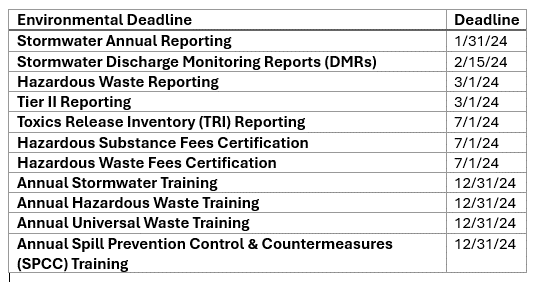2024 CHANGES TO OSHA INJURY AND ILLNESS RECORDKEEPING REQUIREMENTS
What’s Changing:
- Establishments with 100+ employees in certain designated industries are required to electronically submit information from their OSHA Forms 300 and 301 to OSHA once a year.
- OSHA will not collect employee names or addresses, names of health care professionals, or names and addresses of facilities where treatment was provided if treatment was provided away from the worksite from the Forms 300 and 301.
- OSHA is updating the NAICS codes used in appendix A to 29 CFR 1904, subpart E, which designates the industries required to submit their Form 300A data.
- OSHA is adding appendix B to 29 CFR 1904, subpart E, which designates the industries required to submit Form 300 and Form 301 data.
- Establishments will be required to include company name when making electronic submissions to OSHA.
What’s Not Changing:
- Establishments with 20-249 employees in certain industries will continue to be required to electronically submit information from their OSHA Form 300A annual summary to OSHA once a year.
- All establishments with 250+ employees that are required to keep records under OSHA’s injury and illness regulation will also continue to be required to electronically submit information from their Form 300A to OSHA on an annual basis.
Am I required to electronically submit my injuries and illnesses?
- Not every establishment is required to electronically submit through OSHA’s Online Injury Tracking Application. You are required if any of the following apply to you:
- If your establishment had 20-249 employees at any time during the previous calendar year, and your establishment is classified in an industry listed in appendix A to 29 CFR 1904, subpart E, then you must electronically submit information from OSHA Form 300A.
- If your establishment had 250 or more employees at any time during the previous calendar year, and 29 CFR 1904 requires your establishment to keep records, then you must electronically submit information from OSHA Form 300A.
- If your establishment had 100 or more employees at any time during the previous calendar year, and your establishment is classified in an industry listed in appendix B to 29 CFR 1904, subpart E, then you must electronically submit information from OSHA Forms 300 and 301.
2024 ENVIRONMENTAL DEADLINES
As a new year beings, it is always important for a facility to examine upcoming environmental deadlines. This ensures that the facility maintains current knowledge of its environmental obligation and lays the foundation for annual planning to meet those obligations. The following is a compilation of a wide range of environmental deadlines in 2024 that may assist your facility in preparing to maintain environmental compliance in the upcoming year:

THE SERIOUS CITATION AND OSHA’S BURDEN OF PROOF
OSHA’s use of the word “serious” in citations does not mean serious in the ordinary sense of the word. The Occupational Safety and Health Act defines a serious violation as one that presents “a substantial probability that death or serious physical harm could result….” This appears to be internally inconsistent with the words “could” and “substantial probability” used in the same sentence. The Occupational Safety and Health Review Commission (OSHRC) addressed this issue and held that the “probability” of an accident occurring is not relevant. Rather, OSHA’s burden of proof is only to establish by a preponderance of the evidence that IF an accident occurred, then a serious consequence would be substantially probable. For example, the probability of the collapse of a trench dug near stable rock is low. However, if the trench did collapse then an employee would likely suffer a serious injury or death. The word “serious” therefore refers to the potential seriousness of an injury if one occurred based on the facts and the applicable regulation.
The law requires OSHA to prove that the employer violated a safety regulation. In other words, employers are “innocent until proven guilty” of violating a safety regulation. The elements under the law that OSHA must prove to establish a violation are as follows:
- The regulation applies to the safety or health hazard (fall, electrocution, confined space, etc.);
- The employer failed to meet the requirements of the regulation (there was no fall protection, there was no lock out/ tag out policy for electrical work on machines, the confined space regulations were not followed, etc.);
- One or more employees were actually exposed to the hazard so that the employee(s) could have been injured; and
- The employer knew, or with the exercise of reasonable diligence could have known, of the violation of the safety regulation.
OSHA must prove each element by a preponderance of the evidence (more probable than not). Therefore, in analyzing citations, employers should focus on each element of OSHA’s burden of proof to determine whether to contest or negotiate a settlement. It is critical that employers understand that OSHA’s evidence is compiled primarily through inspections which includes interviews of supervisors and hourly employees. Statements by supervisors are imputed as “knowledge” to the company of the violation of a safety regulation. As such, supervisory personnel should be trained thoroughly in the OSHA inspection process and how to relate with OSHA Safety Compliance Officers.
Please contact a member of the Labor and Employment Sections with questions regarding workplace safety issues.

